 |
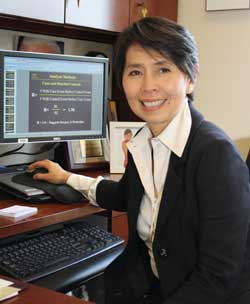
|
|
Emily Chew, Ophthalmologist, Deputy Director, Division of Epidemiology and Clinical Applications, National Eye Institute (NEI), National Institutes of Health (NIH)
|
1. I chose this career because...
2. My typical workday involves...
3. What I like best/least about my work...
4. My career goals are...
5. When I'm not working, I like to...
6. Love what you do...
|
|
1. I chose this career because...
|
Back to Top

|
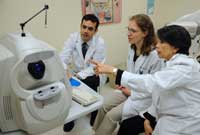
|
|
Dr. Chew is working with several medical fellows who are in-training.
|
I chose to become an ophthalmologist because I was always interested in science and in helping people. At first I thought I would be a pharmacist, but after spending time working in a pharmacy, I realized it wasn’t for me. When I went to college, I ended up in an organic chemistry class with 900 people, a large number of which were planning to go into medicine. I thought that if so many people were interested in medicine, it must be a good thing, so I got into the six-year program that was completely focused on medicine. Sometimes I wish I had gotten a liberal arts degree before going to medical school so I would have had a more rounded educational experience, but I really enjoyed medicine.
I was always very interested in doing more than just treating patients because as gratifying as it is to work with patients one-on-one, in the end, I didn’t feel like I was making as much of an impact as if I were to do research. I kind of lucked into my field of research because I met a woman who who did research on retinoblastoma, a rare cancer of the eye in infants and children. She was an incredible role model—so enthusiastic, so happy in her work—and she turned me on to the work she was doing. It was clear to me that she was having a major impact on the life of these children. I actually ended up doing my residency in ophthalmology because of my exposure to her. Then I went to John Hopkins for a fellowship where research was heavily emphasized.
After doing my fellowship, I returned to Toronto to teach, and eventually came back to the United States to work with NEI. Though I was offered a job at Johns Hopkins, the position at NIH offered me the chance to do something I had never done before, and I wanted to do something new. I thought if I ended up not liking it, I could always go out and practice. But I got hooked and I’ve been here for 20 years!
College Education
2 years undergraduate education, University of British Columbia, http://www.ubc.ca/
and University of Toronto http://www.utoronto.ca/, Canada
Doctor of Medicine, Medical School, and Residency in Ophthalmology, University of Toronto, Canada
Fellowships, Medical Retina, Johns Hopkins University, http://www.jhu.edu/, Baltimore Maryland and University of Nijmegen, http://www.ru.nl/english/, Netherlands
|
|
2. My typical workday involves...
|
Back to Top

|
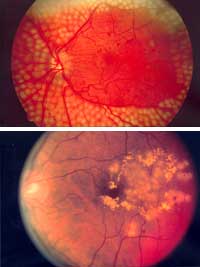
|
|
The eye of a patient with diabetes retinopathy after having laser photocoagulation (top). The eye of a patient with diabetes retinopathy after treatment for macular edema (or swelling of the macula) (bottom).
|
My typical workday depends on whether or not I’m seeing patients. Usually I see patients two days a week, but less than that if I have to go out of town for meetings. The rest of the week is divided between a variety of other tasks. I work with medical students who have taken a year out to learn about research. These are very bright, cream-of-the-crop students, and it’s great to work with them. I mentor students through the Howard Hughes Scholars program and the Clinical Research Training Program here at NIH. I also conduct clinical trials (mostly multi center trials), so that means meeting with statisticians, epidemiologists, and the protocol monitors on the progress of the study. I’m on the editorial board of a couple of journals so I end up doing a lot of reviewing and writing. I’ve also been lecturing once a week lately, so I’m doing a fair amount of travel right now (partly because I want to promote our new study and enroll patients).
Then there is a lot of work going on with our science-oriented studies. For example, we’re now putting up a large trial—4000 patients across 82 clinics—called the Age-Related Eye Disease Study 2 (AREDS2). We’re evaluating the effects of two dietary pigments called xanthophylls that accumulate in the macula and two omega-3 long-chain polyunsaturated fatty acids, on progression to advanced age-related macular degeneration and/or moderate vision loss. We’re looking at the diets habits of people (whether they have disease or not) determining if they are high in these fatty acids. Clearly, people that eat a lot of these seem to have less disease compared to people who never eat them. The xanthophylls are found in leafy green vegetables like spinach and kale. Omega -3 long-chain polyunsaturated fatty acids are found in fish.
We also have some diabetic retinopathy (http://www.nei.nih.gov/health/diabetic/retinopathy.asp) studies, in which we are trying to improve our understanding of the disease and discover better treatments. Diabetic retinopathy is a leading cause of blindness in the United States.
|
|
3. What I like best/least about my work...
|
Back to Top

|
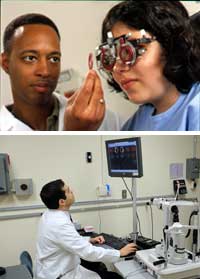
|
|
Dr. Chew’s colleague uses a phoropter on a patient, which is a tool that determines the refractive error (short or far sightedness) of the eye (top). Dr. Chew’s colleague is reviewing results from a fluorescein angiogram, which is used to look at the blood vessels in the eye (bottom).
|
What I like best about my work is that I’m always working on something new and I’m always learning. Also, I like collaborating with people from all different fields of medicine and research. The variety keeps my job very interesting. I collaborate quite a bit with other institutes here at the NIH. It’s so great to work here because you can share in a project without stretching your own resources. I also enjoy mentoring my students. They bring a different perspective to the research, which is always good for us to see and learn from. Plus, the students I work with all have a passion for doing research and excelling.
What I like least about my work is administrative tasks, things you think you can hand-off to someone else, but sometimes you really have to do them yourself.
|
|
4. My career goals are...
|
Back to Top

|
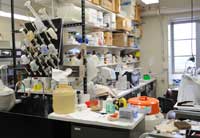
|
|
Dr. Chew’s laboratory, where much of her basic research is performed.
|
My career goals are to continue research that translates into improved and innovative treatments for my patients. In one of our international studies, we are looking at a rare eye disease, Macular Telangiectasia, and collecting information from 22 clinics in 7 countries. It is truly a translational project, because we are looking for the gene (or genes) responsible for the disease in our laboratory work. In the clinic, we are looking at the natural course of the disease. Eventually our efforts will lead to a clinical trial using state-of-the-art imaging techniques to view very thin layers of the retina.
|
|
5. When I'm not working, I like to...
|
Back to Top

|
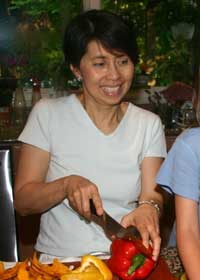
|
|
Dr. Chew prepares vegetables while enjoying family time.
|
When I’m not working, I like to spend time with my 3 daughters. A lot of my activities revolve around them. We are all involved in music. Once daughter plays the violin, another the piano. One is interested in musical theatre and is taking voice lessons.
I love to cook and do a lot of baking. If not for my busy life, I would invite friends over and cook for them more frequently. We have many occasions at my home that revolve around food.
I would love to travel more, because I enjoy it. Fortunately, my work brings me to a lot of places as do the activities I enjoy with my kids.
In my free time, I also volunteer for the Appalachia Service Project http://www.asphome.org/, building houses.
|
|
6. Love what you do...
|
Back to Top

|
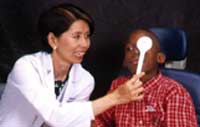
|
|
| |
Dr. Chew performs a simple cover test to observe the behavior of the patient’s uncovered eye as it fixates on a distant target.
|
While this applies to research, it also applies to life in general: you should really love what you do. And sometimes with research you can’t tell if you’re going to love it until you get involved in it. Jump in, get the feel for it and see where it takes you. I don’t think we’re all meant to be researchers and that’s probably a good thing because we want to have variety in life. But if you can find a mentor and develop a love for it, then it’s something that will shape your life forever.
I think meeting role models made a big difference in my life. When you pick a direction you want your life to go in, it’s so important to get encouragement from people who are really engaged in what they’re doing. You feed off their enthusiasm and their love for it as well. I love what I do. I feel very lucky and I have no regrets at all.
|
|
|
|
 |